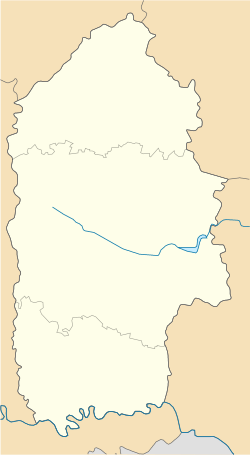Shepetivka
Shepetivka
Шепетівка | |
|---|---|
   Shepetivka railway station, Ostrovsky Museum, Shepetivka District Council | |
| Coordinates: 50°11′0″N 27°04′0″E / 50.18333°N 27.06667°E | |
| Country | |
| Oblast | |
| Raion | Shepetivskyi Raion |
| First mentioned | 1594 |
| Town rights | 1619 |
| Area | |
| • Total | 40 km2 (20 sq mi) |
| Population (2010) | |
| • Total | 43,661 |
| • Density | 1,199/km2 (3,110/sq mi) |
| Postal code | 30400 - 30409 |
| Area code | +380 3840 |
| Website | www.shepetivka.km.ua |
Shepetivka (Template:Lang-uk; Template:Lang-pl, Russian: Шепето́вка, Shepetovka) is a town located on the Huska River in the Khmelnytskyi Oblast (province) of Western Ukraine. The city's population is 43,379 (2013). Shepetivka is a town of oblast subordinance, and the administrative center of Shepetivskyi Raion (district).
Shepetivka is an important railway junction with five intersecting transit routes. It is located 100 km away from Khmelnytskyi, the oblast's capital. The city is known as one of the principal settings of author Nikolai Ostrovsky's classic novel How the Steel Was Tempered.
History
Polish–Lithuanian Commonwealth 1594–1793
Russian Empire 1793–1917
Republic of Poland 1919–1920
Soviet Ukraine 1920–1922
Soviet Union 1922–1991
Nazi Germany 1941–1944 (occupation)
Ukraine 1991–present
A settlement called Shepetivka, belonging to the prince Ivan Zaslavsky, was first mentioned in a written document in 1594. In the 16th century Shepetivka didn’t differ from other settlements of Wolhynia. The settlement had a community and a windmill. It was given Magdeburg Rights at the end of the 16th century. This contributed the settlement’s expansion and growing population. At the turn of the 16th and 17th centuries the peasantry was intensively enslaved. Population of Shepetivka also suffered from frequent attacks of the Crimean Tatars. Peasants and craftsmen responded to the feudal oppression with the revolt in 1591-1593, led by Krzysztof Kosiński, and the revolt in 1594-1596, led by Severyn Nalyvaiko. When during the Ukrainian war of liberation from Poland in July 1648 peasant-Cossack regiments of Maxym Kryvonis had conquered Polonne, the inhabitants of Shepetivka joined the troops. At the end of the 17th century Shepetivka became property of Lubomirski family, and in 1703, of the Sanguszko family. And at the end of the 18th century it became part of Iziaslav county, Volhynian Governorate. In 1866 Shepetivka became the capital of the county.
The first written mention of Shepetivka was in 1594. In 1795 it became part of Iziaslav County, Volhynian Governorate. The first railway station was built in 1873.
In 1923 it got the status of a town, becoming the capital of Shepetovka district. In 1932 it became the capital of Shepetivka Raion, Vinnytsia Oblast. In 1937 Shepetivka Raion became part of Kamianets-Podilskyi (since 1954 Khmelnytskyi) Oblast.
Notable residents
- Valentina Matviyenko, governor of Saint Petersburg, was born in Shepetivka
- Ignacy Jan Paderewski, pianist, composer, and Polish prime minister, lived near Shepetivka as a child
- Nikolai Ostrovsky, Soviet writer, lived here during his childhood and adolescent years
Gallery
-
Church of Nativity in Shepetivka
-
Shepetivka museum
-
Palace of Justice
-
Great Synagogue in Shepetivka
-
Shepetivka Railway Station
-
A street in Shepetivka
-
Moscow Patriarchate church
-
City Hall
-
Ostrovsky Museum
-
Shepetivka park














